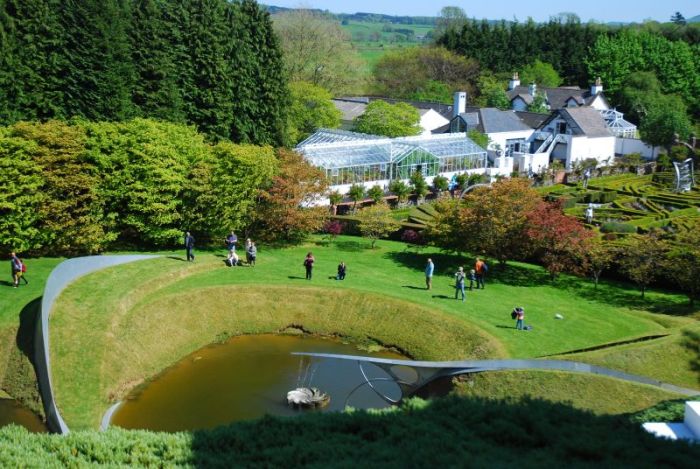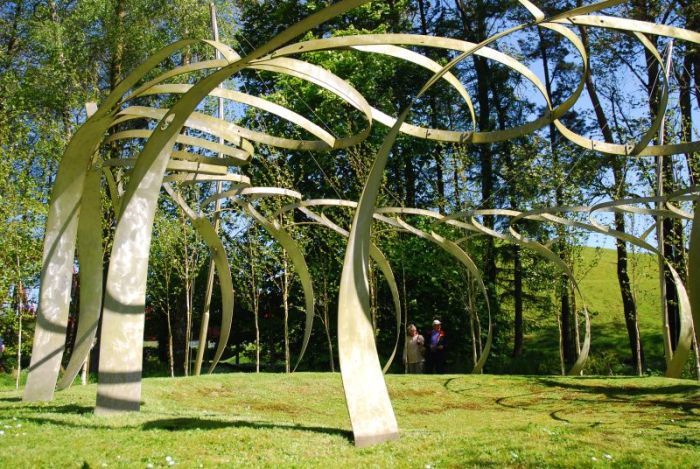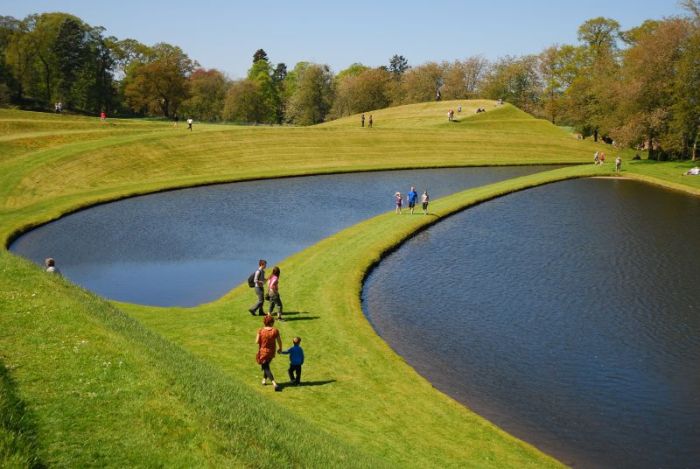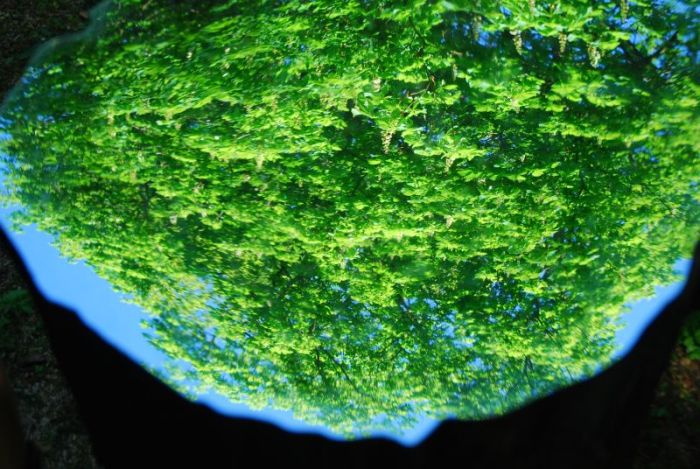We’re driving north to the Scottish borders to visit the Garden of Cosmic Speculation, designed by Charles Jencks and open on just one day each year. The road takes us past Lockerbie, which lies some miles south of Jenck’s garden. There are unavoidable thoughts. In the book he wrote about the making of the garden, Jencks recalled the December evening in 1988 that imprinted the name of an unassuming town in global consciousness:
Maggie [his wife] went out to speak with Alistair’s wife, Frances. As they were walking in the kitchen garden Maggie saw the sky light up behind Frances’ head, in a great yellow and red ball of fire. More extraordinary than this explosion was the way it reached a peak and then suddenly imploded as if sucked into a vacuum cleaner and then the eerie silence of many seconds – Lockerbie is twelve miles away – followed by the roar of the earth. […]
Lockerbie has still not got over the tragedy of that evening, one that has turned it into a global name for the sudden, arbitrary nature of the catastrophe. Although the wreckage has been expunged and the visual scars healed, the citizens of the town are still marked by this fateful event. Everyone carries the memories of it – and subsequent actions and media coverage – in the back of their mind like a constant bad dream.
During a glorious two days in the Borders, beneath cloudless skies as an extended spell of high pressure continues, my thoughts would sometimes be drawn back to that event: the clear blue skies revealed the constant presence of con trails (above, over the River Nith below Portrack House) as planes regularly traversed the international flight path overhead. By strange coincidence, we returned home to news of the NATO bombing of Gaddafi’s compound that left his youngest son and three of his grandchildren dead, and of the American special forces action resulting in the death of Osama Bin Laden. This is how we have lived in the 21st century: distant turbulence intruding upon private pleasures.
The garden that Charles Jencks, an American-born landscape architect and historian, has developed at Portrack House has been inspired by questions of modern science and the laws of nature. The themes explored include the science of complexity and chaos, fractals, black holes and DNA, and concepts of space and time. These themes are represented by the extensive manipulation of the landscape and siting of individual sculptures and forms. The entire 30 acre site is itself a deliberate, considered sculpture:
The Garden of Cosmic Speculation is a landscape of waves, twists and folds, a landscape pattern designed to relate us to nature through new metaphors presented to the senses.
– Charles Jencks
The garden is situated at Portrack House, just outside the village of Holywood in Dumfries and Galloway, and was established by Charles Jencks and his late wife Maggie Keswick, whose family had owned the property for generations. After Maggie was diagnosed with inoperable cancer in 1993, the couple founded the network of Maggie’s Cancer Caring Centres that has continued to grow and develop since her death in 1995. The annual opening of the garden helps raise money for the Maggie’s Centres.
This is not a plantsman’s garden, but rather harks back to an earlier time when gardens were built to represent themes and ideas, rather than what is now generally considered to be their purpose – as a horticultural display. The garden is a landscape that celebrates the new sciences of complexity and chaos theory and consists of a series of metaphors exploring the origins, the destiny and the substance of the Universe: a celebration of the universe and nature, both intellectually and through the senses. The greenhouse roof is decorated with 12 equations that throw light on the laws of the universe. And the garden’s most prominent feature is the Universe Cascade (top), symbolically tracing the story of life over 15 billion years.
The garden began to take shape when the couple dug out a lake for their children to swim in, sculpting the resulting mound of earth in a double helix – the basic form of DNA – and calling it the Snail Mound. Visitors in 2011 entered the garden at the point of Jenck’s newest creation – the Rail Garden, created alongside the resonant red of the new railway bridge over the river Nith.
The rail garden features an engine pulling metal plates which celebrate the leaders of the Scottish Enlightenment, such as Andrew Carnegie, Robert Burns and the scientist Mary Somerville.
Below is the Willowtwist, a structure made from one single long sheet of aluminum, cut and split twice to form a series of intertwined loops, reminiscent of David Nash’s living Ash Dome.
The centrepiece of the garden is undoubtedly the complex of sinuous waveforms created by the Snail Mound, the Snake Mound and their related lakes. Jencks writes:
Curved and counter-curved shapes are structural and often found in nature, for instance in the meander of a river. Waveforms underlie so many natural activities: sea waves, of course, and sand forms left by the incessant waves on the ocean beach; the vortices caused by pulling a solid object through stationary liquid; the swirls of air currents where warm and cold air meet; and the rock curls evident in mountains, a result of a long, slow geological process of movement.
The DNA Garden is dominated by the silver aluminum curves of the double helix, while embedded in the paths are various codes and symbols. The garden celebrates the five senses, as well as the sixth sense of scientific intuition, called by Einstein fingerspitzengefuhl, that feeling at the tips of one’s fingers.
The Universe Cascade emerges from a terrace at the back of the house, looking, with its brilliant white architecture, like something that might have originated in New Mexico or the canyons of Los Angeles. Actually, it should be read from bottom to top, a cascade of steps each representing a ‘jump’ in the development of the universe, beginning at the beginning of time 12-13 billion years ago in a ‘hidden mystery conveyed by steps descending into a reflective, murky surface of water the depth of which is beyond seeing’.
With the creation of man, the principle of beginning came into the world – which, of course, is only another way of saying that with the creation of man, the principle of freedom appeared on earth….It is the nature of beginning that something new is started which cannot be expected.
– Hannah Arendt
Beyond the house is a sweep of meadow that leads to Crow Wood and the Nonsense. Here, on the Black Hole Terrace, a 20th century sort of ha-ha has been created, incorporating forms that act as a metaphor for bending of space and time in the vortex around a black hole.
Speaking of the ideas that underpin the garden, Charles Jencks has said:
Over several years I have worked on a Scottish landscape called, immodestly, the Garden of Cosmic Speculation, speculating with scientists and others on the fundamental laws and forces behind nature and what they might mean to us. Using growing nature to conjecture on what is basic to the Universe is an old practice common to gardeners, but it raises some unlikely questions.
Most people understand a big distinction between living nature and the laws of nature, that is, organic growth and electromagnetism, and they do not reflect that in a garden as elsewhere the latter may underpin the former. Furthermore, gardens of the last hundred years are for pleasure and relaxation, games and flowers, and not a place for public art.
My late wife Maggie and I started work on this garden around her family home in 1988 and slowly, area by area, it has grown into a landscape with about twenty areas dedicated to the fundamental units of the Universe: a Black Hole Terrace for dining on in the summer months; a DNA Garden of the Six Senses; the Quark Walk; the Universe Cascade and so on. Each insight into deep nature, many of which are recent, becomes translated into nature and sculpture. Landform is my generic name for this genre that cuts across art, landscape, architecture and the customary categories, and there must be something like twenty-five of them throughout the garden. Some landforms refer to theories of folding and fractals, others (when they fail) to catastrophe theory. As every gardener knows, the dialogue with nature is always two-way, and it pays to exploit the unintended consequences of nature’s acts.
Why dedicate a garden to the laws of nature? Partly because everybody relates, consciously or not, to the larger picture; we identify with nature and its various moods and states. … In the Garden of Cosmic Speculation I try out questioning metaphors, and this means that all design is really double design: that is, solving formal and functional problems, and coming up with new, appropriate metaphors (both visual and verbal). For instance, the Black Hole Terrace shows the space-time warps of super-gravity, the event horizons and rips in spacetime.
Public art must of course be understandable and moving, but I believe it also should engage with the basic insights on the cosmos.
Placing the Garden of Cosmic Speculation in the context of symbolic garden design in the past, Roman Krznaric has written:
Look around most of our own gardens today and you’re unlikely to find much symbolism. In fact, since around 1700 gardens in Europe have been largely devoid of allegory and metaphor. Instead gardens are more for pleasure and beauty. We aim to create harmonious combinations of flower colours and foliage textures. We want plants of different heights and shapes. We desire visual splendour in the garden throughout the year. The emphasis is on the senses, especially visual impressions. But this is not the only way to think about garden design…
The idea of symbolic garden design has its origins in ancient civilisations. Thousands of years ago the Persians invented the ‘Paradise Garden’. To enter the garden you would have to cross water channels, which represented the four rivers of heaven. Once inside you would find a profusion of fruit trees, symbolic of the fruits of the earth created by God. The most important contemporary example is Charles Jencks’s ‘Garden of Cosmic Speculation’ in Dumfriesshire, Scotland, which has a DNA garden that is taking symbolic garden design into the future. It contains a series of six cells and in each there is a different kind of idea, which is symbolised by the planting. ‘The planting is subordinate to the design,’ he says, ‘but completes it and fills it out.’












Wonderful post.
could you clarify please, does this mean there’s no chance for someone to visit this place during this year?
Yes – I’m afraid that’s so: the garden is only open one day a year – usually the first Sunday in May.
Hello,
What day will the garden be open in 2013? Do you need tickets/invitations to attend or can anyone go? I would love to go! My boyfriend is a landscape gardener and I would like to take him.
Thanks,
katie
Thanks for reading, Katie. It’s always the first Sunday in May – so next year it’s 5 May. See further details here (the more formal name for the gardens is Portrack House): http://www.scotlandsgardens.org/gardens/garden/6f8a52d7-f7b0-45c2-91fc-999e00d2ac95
Thank you so much for your help and quick reply, I have been searching ‘Garden of Cosmic Speculation’ much more information when looking for Portrack House. Thanks again really appreciated!
Hi – this is meant to be a reply to Katie. The gardens are open from 12 to 5 but as always check nearer the time for the 2013 times. You do not buy tickets in advance, you just turn up. I would suggest you aim to arrive around 10.30 and have a short walk to see the rail bridge from the side of the bridge which is in the car park. The queue at around 11, or 11.15 to be one of the first in to really maximise your time there.
when are open in 2012, as would love to come to the garden’s, and where about are you, your’s Joan Gormley.
It’s usually the first Sunday of the first weekend in May. Visit this page in 2012 for the actual date: http://www.scotlandsgardens.org/garden.aspx?id=e901e1fa-7b6b-4ac9-9053-9f1700c9c8e8
The garden is five miles north of Dumfries. I live in Liverpool.
This place is beautiful…planning to visit it on 1st May next year! Thanks for sharing the pictures!
Just curious – was it very crowded when you visited it? The website states that it opens at 12:00noon; was there a queue to get in and do they limit the number of visitors? I stay in London and it’s quite a journey to get there haha…wouldn’t want it to be a wasted trip
Yes it is busy and certain parts can be crowded (everyone wants to stand on top of the Mound) but it’s a large area and the more distant parts are relatively peaceful. Bear in mind that the approach roads are narrow lanes. We got there early (thinking it opened at 10) and so avoided the later queues. It’s very well organised, though, with a one-way system that keeps the traffic flows both in and out moving – and there is extensive parking in an adjacent field. It’s well sign-posted and there are lots of marshalls. The cafe and toilets can get a bit chocker. But this is to be excpected – it’s only open one day a year. Don’t miss it – it’s a tremendous experience.
Thank you for a wonderful post on this garden. I have just spent some time exploring your site; it is so rich in ideas and reflections. I look froward to exploring more. I particularly enjoyed your post on “Travels With Charley” a book that I like, especially the “redwoods” section, and also because I have a standard poodle who rivals some humans’ level of intelligence.
have you a date yet, for one day only, at garden of cosmic speculation, 2012.
your’s Joan Gormley
It’s usually the first Sunday in May – so probably May 6 in 2012. Visit this page in the new year to be sure of the actual date: http://www.scotlandsgardens.org/garden.aspx?id=e901e1fa-7b6b-4ac9-9053-9f1700c9c8e8
This is an extremely wonderful write up – thank you. My parents live in Dumfries but I have never managed to visit. However, I will be in Dumfries on 6th May so finally I can go.
Thanks, Simon, for your kind comment. I hope – no, I know you will – enjoy the Garden on 6 May.
Tom Creer Looks fabulous. Do we have to book or reserve places to visit in May, or turn up on the day ?
It’s not possible to book. Just turn up – but be there early!
When is the garden open in 2013 ?
First Sunday in May. See earlier comments for more.
Thanks for quick response Gerry. I just thought that was 2012, but then every year is first sunday in may
I come from denmark.
Can I be sure to get in if i show up?
Which airport is the nearest?
Can you give me the exact adress and date for 2013?
See http://www.scotlandsgardens.org/gardens/garden/6f8a52d7-f7b0-45c2-91fc-999e00d2ac95 for details of the location of the gardens and opening time. You should get in, and will avoid the later queues, if you aim to arrive by 11:30 (half an hour before the opening). The nearest airport to Dumfries is Carlisle, although the number of flights there are very limited. The next nearest airport is Glasgow Prestwick International, situated in Prestwick and about four miles north of Ayr.
Hi Jorn
You should aim to arrive between 10.30 and 11. There will probably be a small queue at 11 but the entry is pretty fast and it is well organised. If you arrive early, say 10, you will have half an hour or so for a little walk along the river bank as the car park is a field next to the river right where the large red train bridge is. I would have thought that Glasgow is probably the best airport as it is large, but an alternative may be Newcastle. There are trains which run from both Glasgow and Newcastle to Dumfries, but there is another option of a train from Glasgow to Lockerbie if you are going to be using taxis and not a hire car. A taxi from Glasgow airport to Dumfries is around £90. Edinburgh is also another option for you, and there are trains which run from Edinburgh to Lockerbie too. Dumfries has many very good quality bed and breakfasts, and I normally suggest Rivendell to friends.
Regards
Simon
Thanks, Simon, for giving Jorn a much more detailed and helpful response than mine.
Hi Gerry – I really like your blog. I am from Dumfries so I guess these things help. I have been helping a few other people too.
Hey really i like your post so much you can visit Garden designers Glasgow for related post like you.
Is it possible to reach gardens by bus or what is the nearest stop? I am a student from Glasgow and still I cannot rent a car and the only option for me is public transport… Any suggestions?
There are bus stops shown on the A76 that runs past the way into Portrack house. Try this page for more details: http://www.transportdirect.info/Web2/JourneyPlanning/StopInformation.aspx?x=15%3a14%3a50&SID=saszjaa4150blczk1v4cevva&IsSILanding=true
HI, I stumbled on this site, it’s great, thanks to you I know everything details on the event. I definitely want to visit this place, I live in Liverpool and I would like to know if someone who go to this place the May 5 next, with his car. If yes, someone would have a seat for me?
Of course, I participate in transports costs.
Thanks.
Thanks for the post! This garden is amazing… I found great pictures of the Garden of Cosmic Speculation in Art Days, here is the link! http://www.art-days.com/garden-cosmic-speculation-scotland-2/ Enjoy! :)
Thanks for the link – superb photos!
Would it be possible to book 2 tickets in advance? Me and my friend are coming by bus but since it is sunday, the earliest bus/train arrives to Dumfries 2pm… So we could reach gardens only at around 15. We really dont want to miss opportunity to see these gardens. Thaaanks!
Ana – I have no connection with the garden! But I do know you cannot book in advance. See the comments below for more advice on when to arrive. Put briefly: arrive early!
Hi Gerry Im planning on making the trip to see the garden this Sunday. Do you know if children are allowed? Ive scoured the internet looking for info but can’t see any restrictions. (My daughter is nearly 10 so won’t be trying to swing off the sculptures!). Thanks, Shirley
Hi Shirley. I’m 99% certain there were lots of kids there when we visited. Have a good day!
Hi Shirley, absolutely children are allowed and it is an amazing experience for them. Just note that the slopes of the grass mounds and structures are in fact a delicate moss, and therefore are extremely sensitive and cannot be played on.